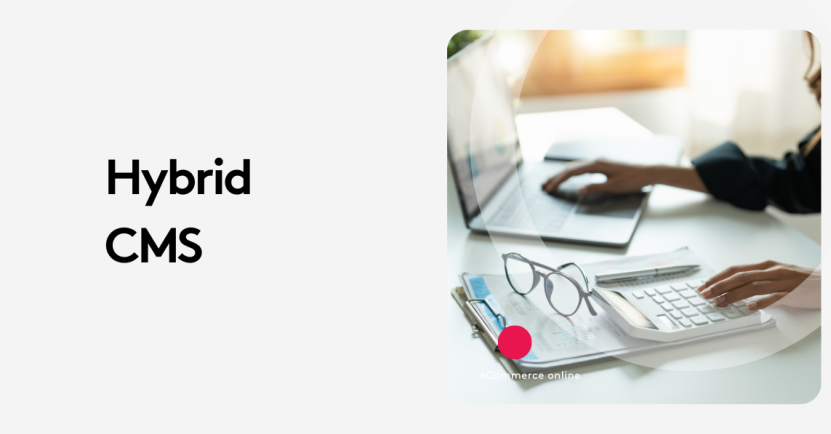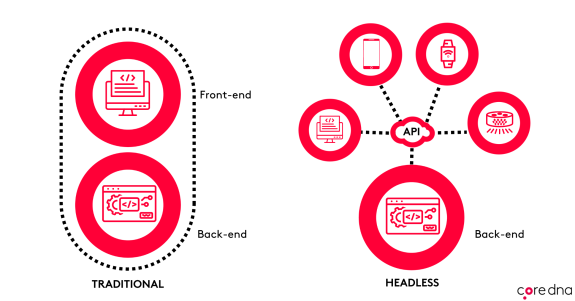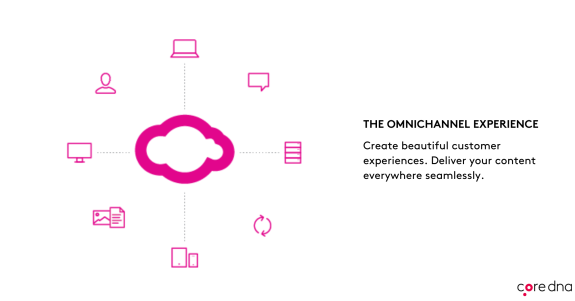Hybrid CMS: A Game Changer or Just Another Buzzword?

With so much hype around headless CMS, is a Hybrid CMS the smarter choice or just another marketing trend? This article breaks down the pros, cons, and whether a hybrid approach is right for your business. Having the right tools to create such content is critical to be able to deliver it everywhere, anytime and in great shape.
If you do a search for "headless content management system," all you'll see are articles talking about its advantages and benefits. But understanding cms architecture and how headless works will help you determine what is the right cms solution for your business.
Key takeaways
- Headless CMS offers flexibility by separating the front-end and back-end, making it ideal for complex, multi-channel content distribution.
- Hybrid CMS combines the best of both worlds, providing the flexibility of a headless CMS with the usability of a traditional CMS for marketers.
- Headless CMS requires more technical expertise, with no preview options and a higher cost due to the need for front-end developers.
- Hybrid CMS enables better collaboration between developers and marketers, offering features like content preview, template management, and workflows while maintaining API-driven integration.
On this page:
What is a Headless CMS?
In the world of CMS architecture, a headless Content Management System is a backend-only content management system. It gets its name from its structure: the CMS' head (front end) is separate from the body (back end). This detached style of CMS was originally developed to deliver content to non-browser systems like applications for phones and internet-of-things (IoT) devices.
Today, it's becoming a popular alternative to traditional CMS tools because it allows you to create highly tailored content to the individual's needs. With no default front-end system, a headless CMS can deliver content to multiple platforms, allowing you to select where and how to present your content instead of relying on a templating system.
Because your content is raw, you can publish it anywhere, through any framework, which is helpful for omnichannel content efforts.

How does Headless CMS work?
A traditional CMS architecture becomes headless when the front end is decoupled from the back-end and an application programming interface (API) is included. A headless CMS serves content via APIs, which is also called API-first content management system.
Detaching the database from the presentation layer makes content easy to deliver. A developer retrieves the content stored in the back-end via the API and sends it to your app or device. Companies usually rely on a headless CMS when they want to serve dynamic content to other entities.
A headless CMS allows you to share the same content on different websites, such as a product description if you're selling the same thing on multiple storefronts. It's great for managing a single content database while sharing it in numerous places.
To recap, the structure of a headless CMS platform includes three components: a content database, the content management backend, and an API to send your backend content to whatever frontends (application or device) you choose. This allows you to easily transfer the same content to different channels while removing the need for maintaining a delivery system for each channel

What are the advantages of a Headless CMS?
The primary shortcoming of using a traditional CMS is that it is not cross-platform and can only be used as a web application. With a headless CMS, you can:
- Reusability: Repurpose the content of a blog across channels and systems (i.e., inside a mobile app or another application). With an API, you can efficiently distribute content across linked platforms. A Headless CMS can deliver a fluid online experience for users, whether viewing your content on your website, in a native app, or wearable device.
- Composability: Design the elements of your blog in different content structures, depending on the blog post. Headless CMSs are design-agnostic, enabling you to structure your content to better serve it across multiple platforms and devices. Marketers and developers alike will rejoice.
- Full content control: Headless systems can programmatically capture and manipulate the content. (i.e., select and edit a section of the information, change the proportion of images, etc.
- Improved Functionality: A headless CMS can show customized content across various channels and will boost speed more than WordPress. A speedier website or application ensures you can secure better conversion rates, which benefits business development.
- Easy Editing Capabilities:Headless CMS separates code from content, so editors can ignore the code and focus on the text. All updates are delivered to all digital assets and allow you to reuse and mix material. Also, API-delivered content is the best for integrating, altering, and disseminating, helping to speed up the creation of content-driven sites and apps.
- Developer-approved: Developers can leverage the newest tools and frameworks to create content experiences on any modern platform without being limited by a proprietary language or traditional CMS. Since your developers will utilize APIs to get content, they don't require a CMS-specific template or ineffective frameworks.
- Enhanced Flexibility and Scalability: Using a headless CMS allows you to create a front-end framework that is appropriate for your project. Also, the separation of the back and front-ends enables easy scaling. A headless CMS also eliminates downtime during maintenance. Furthermore, the material given via APIs is easier to maintain and distribute without interfering with the functionality of your website.
- Better Security: Relying on APIs gives your site a security boost because it can hide behind one or more layers of code. Because the publishing platform can't be accessed via the database, the headless CMS reduces DDoS attacks. Also, access is restricted to the organization, and content can be encrypted and/or decrypted.
It all sounds great doesn’t it! So where is the trap?
What are the limits of a Headless CMS?
While headless CMS is popular for many reasons, it might not be the solution for every business.
- More Complex and need for developers: The flexibility that makes headless cms great can also be a disadvantage for some businesses. As front-end developers are needed to design the user experience for each content across the multiple channels you will be using. For medium-size enterprises, headless might not make sense as it would require a dedicated team developer to create and maintain the front end for each channel. Headless makes more sense for more complex business.
- No WYSIWYG for content creators: A pure headless CMS lacks the option to preview the content you are creating. This is a big turn off for most, if not all content creators. Not having that presentation layer means going in blind when it comes to publishing content. This is one of the major issues with pure headless.
- Some businesses just don’t need headless: While advantageous for complex business architectures that need content delivered across multiple channels or marketplaces ( amazon Alexa, video streaming service, LLM ... ), the headless cms architecture does not offer any benefit for most medium sized enterprises with straight forward needs.
Alternatives to a Headless CMS
So, if you are in the category of business where headless cms seems more of a hassle than a solution - we have the answer for you.
Don't get us wrong a strong API offering is a real advantage when it comes to the platform you will choose to support your online presence because it will allow you to connect all your tech stack and create coherent user experiences and strong data.
But headless is not the only API-first architecture. Today, enterprises have access to a new type of content management systems called Hybrid. meaning they combine the advantages of traditional CMS - WYSIWYG editor for content creators, templating for a faster time to market, a better user experience for marketers - and the advantages of Headless- a strong API offering to allow for scaling into other channels and integration across the company's tech stack.
Let's look deeper into Hybrid CMS.
What is a Hybrid CMS?
So Hybrid CMS is basically the best of both worlds: The Hybrid CMS, the better, more perfected version of headless. Recently there has been a lot of buzz around the word "Universal CMS" which is just a new fancy word to refer to "hybrid CMS". This new buzz in the tech community comes from the frustration and deception of Headless CMS and the desire of marketers to have features that they consider essential to do their jobs and achieve their goals. For example: visual preview, visual content editing, visual building of digital experiences.
What hybrid CMS brings to the table is being able to put back the content creators, marketers and developers on an equal playing field, giving them all the tools they need to do their jobs independently. You can add preview options to your content, you can integrate 3rd party services for extra features and you can create a marketers/ content editor user-friendly environment.
With hybrid CMS, developers and marketers are finally on the same page. The freedom and flexibility of headless is also translated into an easy to use, editable and versatile platform that supports scaling content management across multiple brands, languages, and countries.
Hybrid CMS explained in video
What are the features that make a Hybrid CMS the best of both worlds?
A hybrid content management system (CMS) combines the best features of both traditional website builders and full-featured content management systems.
- Flexibility of a website builder with the power of a CMS:A hybrid content management system allows users to add pages and posts to their site without having to know any coding knowledge. It offers both a visual editor and a drag-and-drop interface hybrid is your answer. You are able to customize your site's look and feel right from the beginning.
- Content authoring: Hybrid cms also offers all the content authoring the marketers love:
- Preview capabilities
- Template management,
- Website navigation,
- Multisite management,
- SEO,
- Drag and drop features,
- Version management.
- Scheduling content
- Strong API ecosystem: Both pure headless and hybrid CMS are API-driven offering you the ease of integration with all 3rd party platforms.
- Developers and Marketers collaborate: hybrid content management system (CMS) that unites both marketing-powered experiences and developer-driven innovation.
- Workflows: Allowing all stakeholders to create different workflows within the CMS such as editorial workflows, compliance workflows and preview workflows.
Conclusion
As the CMS world evolves, there is a clear shift of moving away from pure headless CMS and embracing the idea of a new type of CMSs that would combine the Headless capabilities while still offering marketers the features that help them do their job efficiently. This the direction the industry is taking and while we make a distinction between headless, hybrid, universal CMS, we believe that in the upcoming year, there will be only one type of CMS and that is one that offers all the flexibility a developer wants with all the features a marketer needs.
If you are researching what CMS would work best for your company keep in mind that you need a platform that works for all stakeholders. The best way to go about it is to list the requirements and look into a CMS that can fulfill most of them while offering a user friendly platform for the daily stakeholders.
You can learn more about Headless CMS by downloading the guide below 👇













